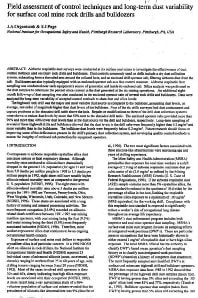Mining Publication: Field Assessment of Control Techniques and Long-Term Dust Variability for Surface Coal Mine Rock Drills and Bulldozers
Original creation date: September 1999
Authors: JA Organiscak, SJ Page
NIOSHTIC2 Number: 20023678
Int J Surf Min Reclam Environ 1999 13:165-172
Airborne respirable dust surveys were conducted at six surface coal mines to investigate the effectiveness of dust control methods used on rotary rock drills and bulldozers. Dust controls commonly used on drills include a dry dust collection system, exhausting from a shrouded area around the collared hole, and an enclosed drill operator cab, filtering airborne dust from the cab. Bulldozers are also typically equipped with an enclosed operator cab as a dust control measure. Airborne respirable dust sampling was conducted near each equipment's source of generation and inside its enclosed cab. Silica analysis was performed on the dust samples to determine the percent silica content in the dust generated at the six mining operations. An additional eight-month follow-up of dust sampling was also conducted in the enclosed operator cabs of several rock drills and bulldozers. Data were analyzed for long-term variability of accepted control methods to abate dust and silica levels. The highwall rock drill was the major and most variable dust source as compared to the bulldozer, generating dust levels, on average, one order of magnitude higher than dust levels of the bulldozer. Four of the six drills surveyed had dust containments and capture problems at the shrouded drill table above the hole. Repairs or modifications to three of the drill dust collection systems were shown to reduce dust levels by more than 50% next to the shrouded drill table. The enclosed operator cabs provided more than 90% and more than 40% lower dust levels than at the dust source for the drill and bulldozers, respectively. Long-term sampling of several of these highwall drills and bulldozers showed that the dust levels in the drill cabs were frequently higher that 0.2 mg/m3 and more variable than in the bulldozers. The bulldozer dust levels were frequently below 0.2mg/m3. Future research should focus on improving some of the deficiencies present in the drill's primary dust collection system, and developing quality control methods to ensure the integrity of enclosed cab protection for equipment operators.

NIOSHTIC2 Number: 20023678
Int J Surf Min Reclam Environ 1999 13:165-172